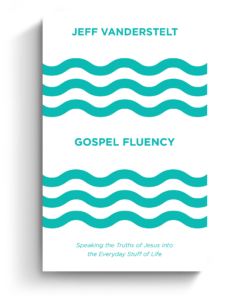In a recent visit to a bookstore one of my kids found a small hardback, filled with short, funny descriptions of several well-known stories. We all began laughing aloud when we discovered the spread in the book with a two-sentence summary of Narnia: “A lion eats a witch in a wardrobe. Some kids watch.”
To be fair, that is what the first Narnia book is about. But if that were all The Lion, the Witch, and the Wardrobe were about, we wouldn’t still be talking about it today, 70 years after its original publication. There’s a deeper magic to the story that gives younger readers a taste of enchantment, and older readers an invitation to re-enchantment.
Yet not everyone is entirely thankful when they discover the Christian themes of Lewis’s Narnia. Laura Miller, co-founder of Salon.com, admits she felt duped as a teenager when she realized the Christian subplot of this world centered around a talking lion. Author J. K. Rowling says she enjoyed Narnia as a child because she didn’t find Lewis “especially preachy,” but in re-reading the books as an adult, she says his “subliminal message isn’t very subliminal.”
It’s almost as if Lewis anticipated the effect of disenchantment in the opening pages of Wardrobe. Lewis dedicated it to his good friends’ daughter Lucy Barfield. Her parents adopted her when she was only 2, and Lewis became Lucy’s godfather. Here’s his dedication to her:
My dear Lucy,
I wrote this story for you, but when I began it I had not realized that girls grow quicker than books. As a result you are already too old for fairy tales, and by the time it is printed and bound you will be older still. But some day you will be old enough to start reading fairy tales again. You can then take it down from some upper shelf, dust it, and tell me what you think of it. I shall probably be too deaf to hear, and too old to understand a word you say, but I shall still be
Your affectionate godfather,
C. S. Lewis
Lewis told Lucy that now she might be too grown up for fairy tales, but one day she’d be old enough to read them again. This is the process of enchantment and disenchantment, which Lewis explains in his essay “Talking About Bicycles.” He describes it in four stages—un-enchantment, enchantment, disenchantment, re-enchantment—using riding bicycles to make his point.
In the first state, what Lewis calls un-enchantment, a bike means nothing to a child who can’t yet ride. Once they have the opportunity, though, it’s a near-magical experience. In time, as with all things, the bicycle becomes a mere means to an end, a way to get somewhere. In this stage a person becomes disenchanted. But if in adulthood they will get back on two wheels, they will rediscover the joy of gliding down the pavement without a care in the world.
So it is for the power of story. Lewis warned Lucy she might be dangerously close to the disenchanted stage. But in time, he hoped, she could find re-enchantment in the pages of this book dedicated to her, and in the land far beyond the wardrobe.
Lewis wasn’t just trying to sell books or entertain readers. His narrative was pointing somewhere.
Weaving a Spell
Lucy’s father, Owen Barfield, once said of Lewis: “Somehow what he thought about everything was secretly present in what he said about anything.” Lewis’s Christian view of the world was never detached from his stories. For example, you can often find in essay-form topics that Lewis put into the plots of his fiction. For about any theme in, say, Lewis’s sci-fi trilogy, you can find passages in his non-fiction works engaging the same things, often written around the same time. Lewis preferred a multi-pronged attack.
“Spells are for breaking enchantments as well as for inducing them,” Lewis said in his famous talk “The Weight of Glory.” If Lewis was seeking to weave a spell with his pen, it was to awaken a world lulled into slumber by a relativistic and atheistic version of reality. A cold vision of the cosmos, centered on the intellect and captive to the physical sciences, was leading a generation through the valley of disenchantment. So Lewis used narrative to sneak past their ready-made rational defenses—what he called “watchful dragons.”
That’s why, when Carl F. H. Henry asked Lewis to write articles for the inaugural edition of Christianity Today, Lewis declined. Lewis told Henry he felt his gifts were best used to “smuggle theology behind enemy lines.” Indeed, it was during this chapter of Lewis’s life that he published all the Narnia stories. Though Lewis wasn’t writing direct theological pieces, one thing was clear: Aslan was on the move.
Lewis’s writing is timeless because he avoided Christian jargon, was disconnected from denominational tribalism, resisted “chronological snobbery,” exposed and challenged fuzzy thinking of alternative worldviews, and baptized our imagination so we could see reality in all of its God-glorifying wonder. And for many of us, the introduction to this view of the world began with a journey through a wardrobe.
It may be that, like Lucy Barfield, our secular age is too old for fairy tales. Perhaps one day it will grow old enough to begin reading them again. To get there, though, we need re-enchantment. Christian leaders often describe methods designed toward this end as “cultural apologetics”—and more times than not, they point to Lewis as the primary example.
Knowing Aslan Better
The year Lewis died, Lucy Barfield was only 28. That same year she began having medical problems that were later diagnosed as multiple sclerosis. She spent four decades fighting the illness, mostly bedridden. Near the end of her life, when she was no longer able to read, her brother Geoffrey read the Narnia stories aloud by her hospital bed.
Lucy died in 2003. Though never able to have children of her own, she received letters from children over the years who were introduced to her by way of the Wardrobe dedication. Many of them thought she was the actual character Lucy, the first to meet a faun by the lamppost, who went on to lead generations of children to follow in her steps. “What I could not do for myself, the dedication did for me,” Lucy said, “My godfather gave me a greater gift than I had imagined.”
Lewis gave us all a great gift in Narnia. In that fantasy world, we find enchantment and, when needed, re-enchantment for all that matters most in our world. I can’t help but think of his aspiration for Aslan’s legacy, which he expresses through the lion in The Voyage of the Dawn Treader. And as you might imagine, it includes Lucy:
“It isn’t Narnia, you know,” sobbed Lucy. “It’s you. We shan’t meet you there. And how can we live, never meeting you?”
“But you shall meet me, dear one,” said Aslan.
“Are—are you there too, Sir?” said Edmund.
“I am,” said Aslan. “But there I have another name. You must learn to know me by that name. This was the very reason why you were brought to Narnia, that by knowing me here for a little, you may know me better there.”
From the pen of a former atheist who took a long intellectual path to Christian faith—a path punctuated by longings for joy—came one of the most memorable stories of our time.
When Lewis was still a skeptic, no other author influenced him more than George MacDonald, who, as Lewis describes, baptized his imagination through fantasy stories. Lewis once said of MacDonald, “Every now and then there occurs in the modern world a genius . . . who can make such a story.” Indeed. The same may be well said of Lewis himself, the man who gave us a lion-king who reminds us of a deeper reality—the deepest reality of all.
“The Most Practical and Engaging Book on Christian Living Apart from the Bible”
 “If you’re going to read just one book on Christian living and how the gospel can be applied in your life, let this be your book.”—Elisa dos Santos, Amazon reviewer.
“If you’re going to read just one book on Christian living and how the gospel can be applied in your life, let this be your book.”—Elisa dos Santos, Amazon reviewer.
In this book, seasoned church planter Jeff Vanderstelt argues that you need to become “gospel fluent”—to think about your life through the truth of the gospel and rehearse it to yourself and others.
We’re delighted to offer the Gospel Fluency: Speaking the Truths of Jesus into the Everyday Stuff of Life ebook (Crossway) to you for FREE today. Click this link to get instant access to a resource that will help you apply the gospel more confidently to every area of your life.

































